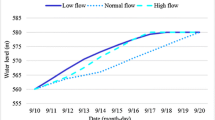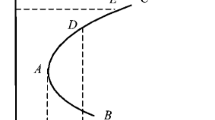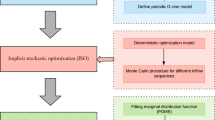Abstract
Bayesian stochastic dynamic programming (BSDP) has been widely used in hydropower generation operation, as natural inflow and forecast uncertainties can be easily determined by transition probabilities. In this study, we propose a theoretical estimation method (TEM) based on copula functions to calculate the transition probability under conditions of limited historical inflow samples. The explicit expression of the conditional probability is derived using copula functions and then used to calculate prior and likelihood probabilities, and the prior probability can be revised to the posterior probability once new forecast information is available by Bayesian formulation. The performance of BSDP models in seven forecast scenarios and two extreme conditions considering no or perfect forecast information is evaluated and compared. The case study in the Ertan hydropower station in China shows that (1) TEM can avoid the shortcomings of empirical estimation method (EMM) in calculating the transition probability, so that the prior and likelihood probability matrices can be distributed more uniformly with less zeros, and the problem that the posterior probability cannot be calculated can be avoided; (2) there is a positive correlation between operating benefit and forecast accuracy; and (3) the operating policy considering reliable forecast information can improve hydropower generation. However, an incorrect decision may be made in the case of low forecast accuracy.






Similar content being viewed by others
Notes
In China, a month can be divided into three periods of approximately 10 days each: the first 10 days (early), the middle 10 days (mid) and the rest days (late) of the month.
References
Ahmadianfar I, Samadi-Koucheksaraee A, Bozorg-Haddad O (2017) Extracting optimal policies of hydropower multi-reservoir systems utilizing enhanced differential evolution algorithm. Water Resour Manag 31:1–23
Birhanu K, Alamirew T, Dinka MO, Ayalew S, Aklog D (2014) Optimizing reservoir operation policy using chance constraint nonlinear programming for Koga Irrigation Dam, Ethiopia. Water Resour Manag 28:4957–4970
Celeste AB, Billib M (2009) Evaluation of stochastic reservoir operation optimization models. Adv Water Resour 32:1429–1443
Chandramouli V, Deka P (2005) Neural network based decision support model for optimal reservoir operation. Water Resour Manag 19:447–464
Genest C, Rémillard B, Beaudoin D (2009) Goodness-of-fit tests for copulas: a review and a power study. Insurance Math Econ 44:199–213
Harboe R (1993) Explicit stochastic optimization. Springer, Dordrecht
Karamouz M, Vasiliadis HV (1992) Bayesian stochastic optimization of reservoir operation using uncertain forecasts. Water Resour Res 28:1221–1232
Karmakar S, Simonovic SP (2010) Bivariate flood frequency analysis. Part 2: A copula-based approach with mixed marginal distributions. J Flood Risk Manag 2:32–44
Kim YO, Palmer RN (1997) Value of seasonal flow forecasts in Bayesian Stochastic Programming. J Water Resour Plan Manag 123:327–335
Lei XH, Tan QF, Wang X, Wang H, Wen X, Wang C, Zhang JW (2017) Stochastic optimal operation of reservoirs based on copula functions. J Hydrol:557, 265–275
Li L, Liu P, Rheinheimer DE, Deng C, Zhou Y (2014) Identifying explicit formulation of operating rules for multi-reservoir systems using genetic programming. Water Resour Manag 28:1545–1565
Liao S, Liu B, Cheng C, Li Z, Wu X (2017) Long-term generation scheduling of hydropower system using multi-core parallelization of particle swarm optimization water resources management an international. Water Resour Manag 31(9):2791–2807
Massey FJ (1951) The Kolmogorov-Smirnov test for goodness of fit. Publ Am Stat Assoc 46:68–78
Mcyer PL (1970) Introductory probability and STATISTICAL application. Addison-Wesley Publishing Company, Hoboken
Mehta R, Jain SK (2009) Optimal operation of a multi-purpose reservoir using Neuro-Fuzzy technique. Water Resour Manag 23:509–529
Mujumdar PP, Nirmala B (2007) A Bayesian Stochastic optimization model for a multi-reservoir hydropower system. Water Resour Manag 21:1465–1485
Opan M (2010) Irrigation-energy management using a DPSA-based optimization model in the Ceyhan Basin of Turkey, 385. J Hydrol:353–360
Reddy MJ (2012) Bivariate flood frequency analysis of upper godavari river flows using Archimedean Copulas. Water Resour Manag 26:3995–4018
Ren D (2016) Outlook for renewable energy development of 13th Five Year Plan Science & Technology Review
Shi Y, Yong P, Wei XU (2016) Optimal operation model of cascade reservoirs based on grey discrete differential dynamic programming. J Hydroelectr Eng 35(12):35–44
Simonovic SP, Burn DH (1989) An improved methodology for short-term operation of a single multipurpose reservoir. Water Resour Res 25:1–8
Sklar M (1959) Fonctions de repartition a n dimensions et leurs marges. Publ. Inst. Statist. Univ., Paris, p 8
Tan QF, Wang X, Liu P, Lei XH, Cai SY, Wang H, Ji Y (2017) The dynamic control bound of flood limited water level considering capacity compensation regulation and flood spatial pattern uncertainty. Water Resour Manag 31:143–158
Tan QF, Lei XH, Wang X, Wang H, Wen X, Ji Y, Kang AQ (2018) An adaptive middle and long-term runoff forecast model using EEMD-ANN hybrid approach. J Hydrol 567:767–780
Tan QF, Lei XH, Wen X, Fang GH, Wang X, Wang C, Ji Y, Huang XF (2019) Two-stage stochastic optimal operation model for hydropower station based on the approximate utility function of the carryover stage. Energy 183:670–682
Tang GL, Zhou HC, Li NN, Feng W, Wang YJ, Jian DP (2010) Value of medium-range precipitation forecasts in inflow prediction and hydropower optimization. Water Resour Manag 24:2721–2742
Willis R, Finney BA, Chu WS (1984) Monte Carlo optimization for reservoir operation. Water Resour Res 20:1177–1182
Xie M, Zhou J, Li C, Zhu S (2015) Long-term generation scheduling of Xiluodu and Xiangjiaba cascade hydro plants considering monthly streamflow forecasting error. Energy Convers Manag 105:368–376
Xu W, Zhang C, Peng Y, Fu G, Zhou H (2014) A two stage Bayesian stochastic optimization model for cascaded hydropower systems considering varying uncertainty of flow forecasts. Water Resour Res 50:9267–9286
Yan B, Guo S, Guo J, Chen L, Liu P, Chen H (2010) Regional design flood composition based on Copula function. J Hydroelectr Eng 29:60–65
Yazdi J, Moridi A (2018) Multi-objective differential evolution for Design of Cascade Hydropower Reservoir Systems. Water Resour Manag 32(14):4779–4791. https://doi.org/10.1007/s11269-018-2083-5
Yun R, Singh VP (2008) Multiple duration limited water level and dynamic limited water level for flood control, with implications on water supply. J Hydrol 354:160–170
Zhao T, Cai X, Lei X, Wang H (2011) Improved dynamic programming for reservoir operation optimization with a concave objective function. J Water Resour Plan Manag 138:590–596
Zhao T, Yang D, Cai X, Zhao J, Wang H (2012) Identifying effective forecast horizon for real-time reservoir operation under a limited inflow forecast. Water Resour Res 48:1540
Acknowledgements
This work was supported by the National Natural Science Foundation of China (U51909063, U1765201), the China Postdoctoral Science Foundation (2019 M651681), the Fundamental Research Funds for the Central Universities of China (2019B11514), the National Key Research and Development Project of China (2018YFC1508200). The authors also thank the support from international Clean Energy Talent Program (iCET) from China Scholarship Council.
Author information
Authors and Affiliations
Corresponding author
Ethics declarations
Conflict of Interest
None.
Additional information
Publisher’s Note
Springer Nature remains neutral with regard to jurisdictional claims in published maps and institutional affiliations.
Rights and permissions
About this article
Cite this article
Tan, Qf., Fang, Gh., Wen, X. et al. Bayesian Stochastic Dynamic Programming for Hydropower Generation Operation Based on Copula Functions. Water Resour Manage 34, 1589–1607 (2020). https://doi.org/10.1007/s11269-019-02449-8
Received:
Accepted:
Published:
Issue Date:
DOI: https://doi.org/10.1007/s11269-019-02449-8




